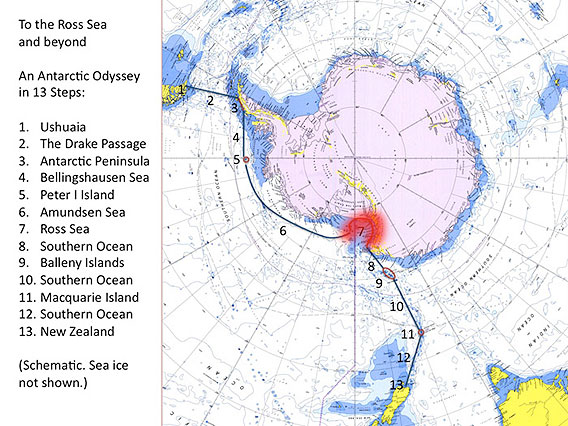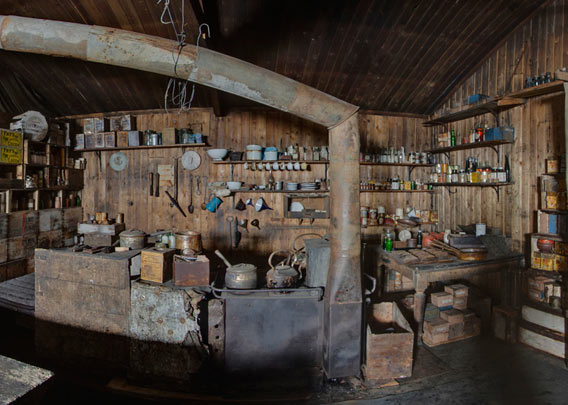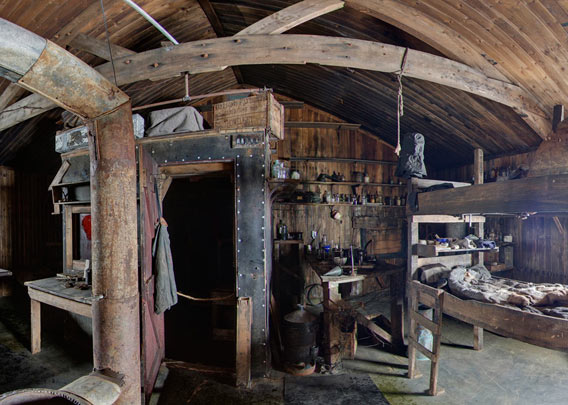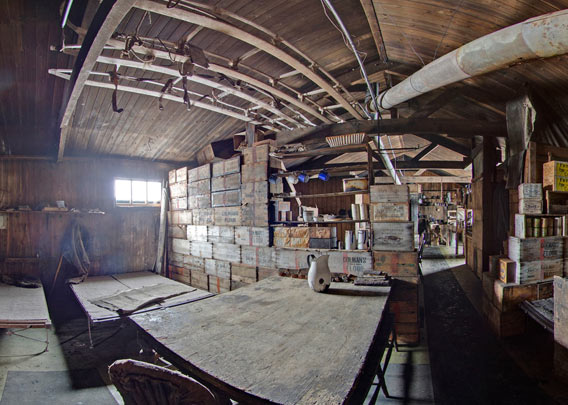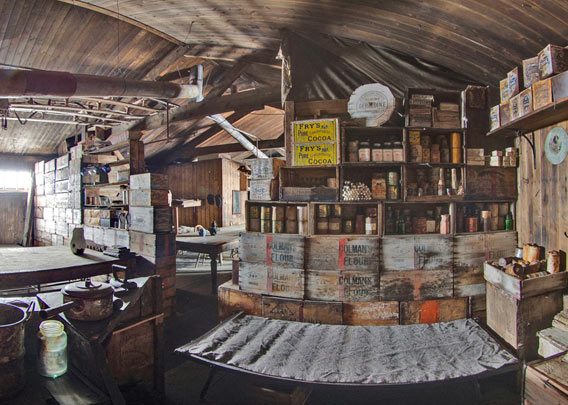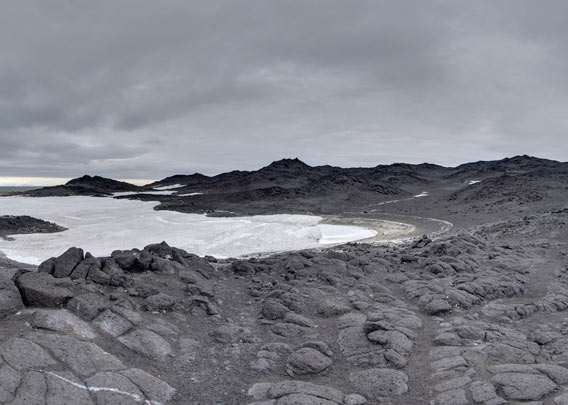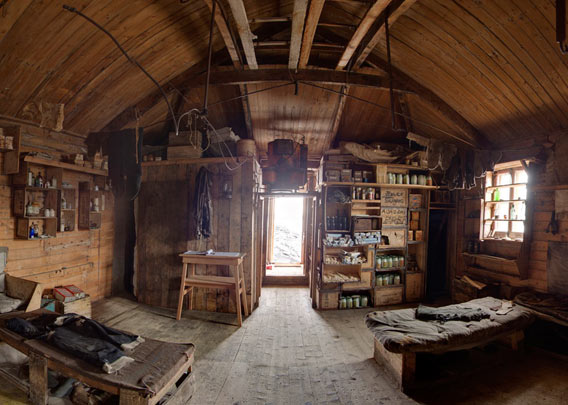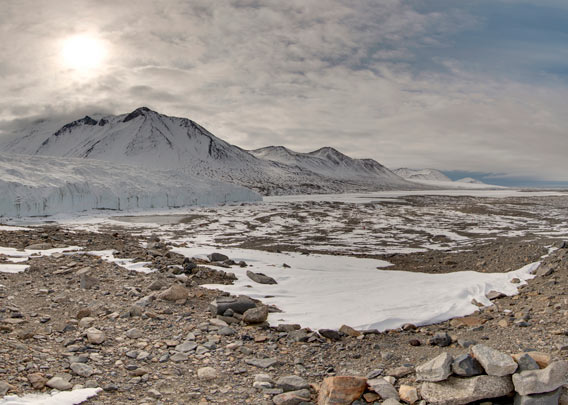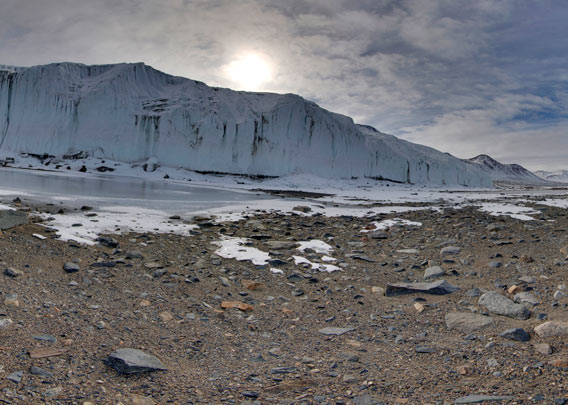Seitenstruktur
-
Spitsbergen-News
- Select Month
- March 2020
- February 2020
- March 2019
- January 2019
- December 2018
- September 2018
- June 2018
- May 2018
- April 2018
- March 2018
- February 2018
- January 2018
- December 2017
- November 2017
- October 2017
- September 2017
- June 2017
- May 2017
- April 2017
- March 2017
- February 2017
- January 2017
- December 2016
- September 2015
- April 2015
- March 2015
- February 2015
- January 2015
- December 2014
- October 2014
- August 2014
- June 2014
- May 2014
- April 2014
- March 2014
- November 2009
- April 2000
- Select Month

| Grytviken |
Home
→ Triplogs & photo galleries
→ Antarctic season 2012/13
→ Antarctica (Ross Sea) 2013/01/16-02/17
→ Gallery 3: The Ross Sea
Ushuaia-Antarctica-New Zealand
Part 3 of 4: The Ross Sea
The amazing Ross Sea was certainly the core of our Antarctic Odyssey. We got our first exciting impressions of the coast of Victoria Land, near Coulman Island, from the helicopters. Thundering with 110 knots (200 km/h) over drift ice, wide coastal glacier plains and along some towering rock cliffs – not exactly what the explorers did 100 years ago, and not quite what you might imagine as polar timelessness, but painfully beautiful! Then we went on, without further delay by drift ice, deeper into the Ross Sea, towards Ross Island and into McMurdo Sound. Our promised land!
Milk and honey would not flow in this promised land, but they would freeze to masses hard as concrete. The Zodiac landing at Cape Evans was certainly amongst the coldest ones ever for me. -14 deg C may, as such, not seem too much (or too little), but combined with wind of 30 knots and more, it is cold enough for anyone who goes ashore in a small boat. Splash water – and you will get splashes in that kind of weather – froze to ice within seconds. The shoe cleaner job outside the old hut was not the most pleasant occupation, but it is an important one: The historical huts are strictly protected, only a limited number of persons is allowed inside and is not only compulsory, but it makes sense indeed, to remove abrasive sand from boots. So the brush was being put into good use inspite of wind and weather
I happened to be the first one of our lot who entered Scotts hut at Cape Evans on Ross Island, and this moment will certainly remain as one of the big moments in my polar memories – which are not just a few. The hut gives you the impression that Scott and his men (or rather: his men, but not Scott himself, obviously, as he had died further south before the expedition left Antarctica) had left the place just a few days ago: there are tins on the shelves – everything very British indeed – and reindeer fur sleeping bags on the bunks (inside-outside, remember? ☺ ). Chemical instruments still on the table under the south-facing window. The wind was howling outside, but it was the spell of history that took our breath for a silent moment inside. And after a few hours, it was cold, really cold. And this is summer down here! How Scott and his men managed to travel here during the much colder winter, in the much colder inland areas, with their much inferior clothing and equipment, remains a mystery. Well, in the end, the South-Pole party didn’t manage, as is well known, but froze and starve to death on the return journey from the pole in a blizzard not far from a life-saving depot. All these stories had, of course, been narrated on board in great detail before we got near McMurdo Sound.
Admittedly, we were wimps, as we were quite happy to return to a comfortable ship after a few hours. Well, had there been the opportunity to remain longer in that hut, even spend a night there … but that was not at all an option.
Another bit of sacred ground of Antarctic history is just a few miles north from Cape Evans, at Cape Royds. This is where Shackleton established himself and his expedition during his first own attempt to conquer the South Pole, the almost successful Nimrod expedition. At least, they returned alive – better an alive donkey than a dead lion, or so Sir Ernest said – and could make another attempt later, then from the Weddell Sea side with the famous Endurance. But that is another story. The story of our first attempt to land is admittedly both less dramatic and of lesser historical significance, but it was nevertheless an interesting one: It was not easy to push with the Zodiac through a 20 meter belt of smaller ice pieces that the wind was pushing towards the fast ice edge. And as soon as we guides had stepped onto the fast ice, establishing a safe walking route to the hut, the wind picked up and packed the ice even denser. Not good. An attempt to pick us up again had to be aborted after considerable, but unsuccessful efforts. No drama though, as we knew that a walk of 2 km would get us to a point were we could get back into the Zodiac. And this is just what we did.
A few hours later, the wind had both changed direction and died down. Some unexpected, hard knocking on my door got my out of deep sleep, and very soon thereafter, we – the small scout team – stood at the gangway, tired, slightly shivering and thinking that a slice of bread and a cup of of tea would have been a good thing, but the one and only thought that had captured our minds was the exciting idea of soon entering Shackleton’s old premises. This time, Cape Royds was indeed easily accessible, and soon we had reached the wholy grale of all Shackleton afficionados: in this simple, but beautiful huts, Sir Ernest and his men had lived, just a few hundred from the world’s southernmost Adelie penguin colony. Shackleton and his man are history, but the penguins are still there. The interiour of the huts put us visitors back in time, into the heroic age of Antarctic exploration. The experience was relatively brief – measured in hours, not months – but intense.
It was and remained windy, but the cloud cover lifted, so we took the opportunity, parked the ship at the ice edge on the west side of McMurdo Sound and after a 15 minutes helicopter flight, we entered another world, not part of the planet Earth as we know it, as we stepped out into Taylor Valley, one of the McMurdo Dry Valleys. Uplift along major geological fault has cut the Dry Valleys off from this world long time ago, protecting it both from the inland ice which would otherwise have flooded these valleys as almost all other land areas in Antarctica, and the Ross Sea. The result is a climate of cold, wind and extreme aridity, that has now prevailed for millions of years and turned the Dry Valleys into a very silent, dead and timeless landscape. Due to the lack of precipitation and warmth, the glaciers are so slow that radiation emitted from the surrounding ground turns their edges into steep ice cliffs – something that I know from glaciers that flow out into the sea, but not from glaciers that and on dry land. Bizarre!
At a first glance, you may think to have seen a similar lack of vegetation in high arctic areas such as northeast Spitsbergen. But there, you will find lichens on the rocks, mosses and at least every once in a while a shy flower. Here – nothing! No matter how many stones you luck at, there is not the slightes trace of life to be seen. This is something only scientists will find, who hunt for it with microscopes and a lot of time.
The logistical circumstances gave Greg, Elke, Julian and me the privilege to spend about 10 partly very calm hours in Taylor Valley, going into some very golden evening and night hours. That may not be very much, but more than most people will get who have the chance to get to this part of the planet. And these are few. To our knowledge, the last tourists who had visited the Dry Valleys had done this in 2009. Another place which now has a lasting, prominent and very dear place amongst my polar memories!
Including the impressive lack of warmth on this nice, only moderately windy Antarctic summer day.
On the next day, the idea was to take the opportunity for a walk out on the fast ice of McMurdo Sound. While we guides were already about to mark a safe area on the ice, it turned out that the ice, while being too thick and hard to park the Ortelius inside it, broke off into large floes at the edge, while the Captain tried to keep the ship alongside. After a number of attempts – nobody can say they didn’t try everything, seriously! – it became clear that this would just not work, and time was running out, so we had to abort the operation. It was just not an option to place near 60 people on large bits of ice, which was about to break up into smaller pieces, each one drifting out into the Ross Sea … While all this maneouvring was happening, we guides stood on the ice, and suddenly two very curious Emperor penguins came quickly towards us, sliding on their bellies across the ice at an amazing pace, to have a look at us and say hello. We were quite aware that we were being watched not without some from the ship, but this did not keep us from enjoying our Antarctic heaven – what else should we have done …
The afternoon brought a strong contrast to all these natural wonders. The US-American McMurdo Base is certainly a dark spot of „civilisation“ in the middle of this supposedly pristine Antarctic wilderness, I can’t think of it any differently. Less obvious to the visitor who does not negotiate with the local officials, but hardly less impressive, were the regulations put upon us tourists by the beaurocracy: Without being officially authorized or accompanied by a local guide, we are not even allowed to walk 100 metres to the shop – of course, there was a great risk of being run over by one of these many massive and rather bizarre vehicles that circulated all over the place. Well, even someone like me who spends a lot of his time in parts of the world that do not know car traffic would say that anyone who has ever managed successfully to cross a road in any village will be able to do the same in the still quite limited traffic of McMurdo Base, but the National Science Foundation does obviously not trust us that far. Neither are postal services available to the „public“; getting some postcards delivered seems to be too much for the otherwise quite impressive infrastructure. Of course – seeing the massive amounts of heavy machinery and people that are regularly transported to and fro New Zealand, McMurdo Base and the South Pole …
One could very well do without a visit to McMurdo Base if the US-Americans had not, sensible as always, placed their station directly next to another holy grail of polar history: Hut Point. This is where Scott had settled down during his Discovery-expedition (1901-1904). Scott’s hut at Hut Point is less well taken care of and accordingly less atmospheric than those huts at Cape Royds and Cape Evans, but still, it is one of the important pivotal points in the history of the discovery of the South Pole, both of the Discovery men and by later expeditions, including Shackleton’s Nimrod expedition and Scott’s last one. So, folks, ignore McMurdo Base for a minute and get down on your knees …
And it is the grand view over inner McMurdo Sound with its fast ice and the subsequent Ross Ice Shelf from Observation Hill that finally answers the question as to why one just has to visit McMurdo if the chance is there – just in case of any remaining doubt …
The tight schedule unfortunately involves a far-too-soon departure already on the next day, February 07, but not without having had a look at the seemingly infinite Ross Ice Shelf, which is one of this planet’s great natural wonders. The great Ice Barrier is stretching for about 800 km eastwards from Ross Island. A sniff of Antarctic infinity. Distant parts are seemingly uplifted, an optical illusion, an effect of a cold bottom layer of air. And again, no less impressive is the cold of this Antarctic summer day: -14 deg C and a very stiff breeze do not invite for breakfast outside on deck. As soon as we turn the bow northwards, after having followed the barrier for a good 3 hours, we go down into the warm, windproof interiour of our good ship for a hearty breakfast. The rest of the day is largely spent sleeping by many.
The Ross Sea (gallery)
- gallery anchor link: #gallery_64
Click on thumbnail to open an enlarged version of the specific photo.
To the gallery:
The Antarctic Peninsula Peter I Island and the Amundsen Sea The Ross Sea Scott Island – Macquarie Island
Panorama: Ross Sea – Cape Evans
The hut at Cape Evans on Ross Island is one of the treasured holy grails of Antarctic history. It was built during Scott’s final expedition with Terra Nova (1910-13). Scott and 4 other men reached the South Pole on January 17, 1912 – about 5 weeks after their Norwegian competitor Roald Amundsen. On the return journey, Scott and his comrades starved and froze to death in their tent during a blizzard on or around March 29. Their frozen bodies were found by other expedition members in November the same year. The diaries were returned and edited; precious reading for all aficionados of south polar history!
Cape Evans – 1/5
Cape Evans – 2/5
Cape Evans – 3/5
Cape Evans – 4/5
Cape Evans – 5/5
Panorama: Ross Sea – Cape Royds
The hut at Cape Royds on Ross Island was built in early 1908 during Shackleton’s Endurance expedition (1907-09). In October 1908, Shackleton and 3 more men, amongst them Frank Wild, started their trek towards the South Pole, but had to turn around 180 km away from their destination due to a lack of provisions. One of the expedition’s other achievements was the first ascent of Mount Erebus.
Panorama: Hut Point
The hut at Hut Point, Ross Island, was built during Scott’s Discovery expedition (1901-04). This first attempt by Robert F. Scott to reach the South Pole was of little success: The pole party, which included also Ernest Shackleton, did not get beyond the Ross Ice Shelf. Scott made important experience with various means of transportation, including ponies, but did not draw the necessary conclusions and consequences when he returned later for his last expedition with Terra Nova. The hut was used on several later occasions, including Shackleton’s Nimrod-expedition and Scott’s Terra Nova expedition. Today, the historical atmosphere of Scott’s hut at Hut Point suffers from its neighbourhood, the US-American base McMurdo.
The hut at Hut Point – 1/2
The hut at Hut Point – 2/2
Panorama: McMurdo Dry Valleys – Taylor Valley
The so-called McMurdo Dry Valleys, west of McMurdo Sound in the Ross Sea, are amongst Antarctica’s highlights in terms of scenery and natural history interest. They are amongst the largest mostly unglaciated land-areas in Antarctica. The reason is the lack of precipitation: there is simply none, apart from some wind that is blown through the valleys by the wind, which can be violent. The valleys appear completely dead, the only life there is microbes that are not visible with the naked eye and live mainly in the few meltwater lakes and streams. Some of these are even hyper-saline. Occasionally, a confused seal comes up into the valleys from McMurdo Sound, losing track in the Antarctic desert, and then dies far away from the coast. Dried by cold and wind, their mummies have been resting in the Dry Valleys for centuries and can still be seen.
Tourists may only visit a limited area near Canada Glacier in Taylor Valley. This area is far away from the coast and can only be reached by helicopter.
To the gallery:
The Antarctic Peninsula Peter I Island and the Amundsen Sea The Ross Sea Scott Island – Macquarie Island
last modification: 2021-03-22 ·
copyright: Rolf Stange
